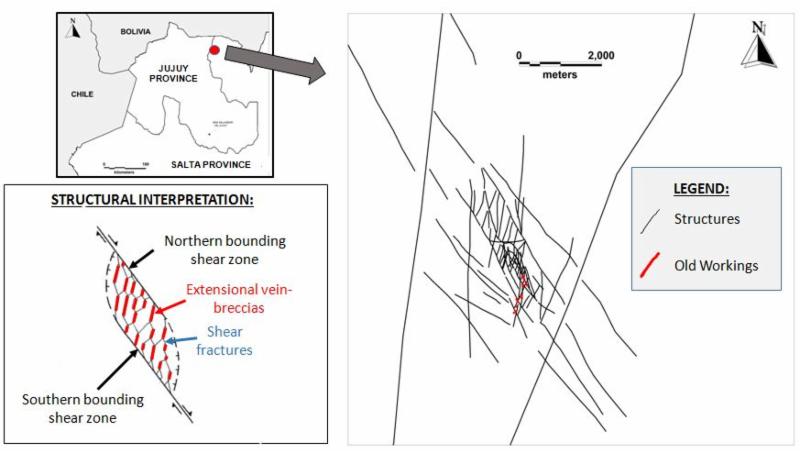U308 Corp. Stakes the Old La Niquelina-Cobalt-Nic... mine
posted on
Mar 30, 2017 10:50AM

Edit this title from the Fast Facts Section

|
U3O8 Corp. Stakes the Old La Niquelina Uranium-Cobalt-Nickel Mine
Toronto, Ontario - March 30, 2017 - U3O8 Corp. (TSX: UWE), (OTCQB: UWEFF)("U3O8 Corp." or the "Company") announces that it has staked the old La Niquelina Mine, a past small producer of uranium, cobalt and nickel, in Salta Province, Argentina.
"The staking of an area of known uranium mineralization represents a first step in expanding our portfolio of targets that we believe to have potential for mineralization that can be extracted at low cost," said Dr Richard Spencer, President and CEO of U3O8 Corp. "The timing of the expansion of our project base underlines our confidence that the uranium market has bottomed. While our focus remains on advancing our flagship Laguna Salada Project through the addition of higher-grade zones and carefully focused metallurgical test work that may result in lower operating cost estimates, La Niquelina Mine is a perfect fit for U3O8 Corp: it strengthens our uranium portfolio while adding a cobalt opportunity to our basket of battery commodities that already includes nickel, vanadium and phosphate. We plan to undertake comprehensive exploration of the La Niquelina area using simple and low-cost field techniques."
Mineralization and the La Niquelina Mine
Mineralization occurs in a system of six partially exposed veins that extend over a distance of approximately 800 metres ("m") and cut a sequence of inter-layered shale and sandstone host rocks. The veins consist of quartz and siderite, an iron carbonate mineral, and are between 1m and 1.5m thick.
Mineralization was discovered at La Niquelina in 1944, with modest production from a small underground mine in the early 1950's. Workings were concentrated in three areas: underground development totaled 180m on Levels 8 and 9 in the central part of the vein system, 70m-90m on Levels 12, 13 and 14 in the northeastern area, and 45m on Level 1 in the southwestern area. Cobalt values are reported to have ranged between 0.74% and 1.76%, and those of nickel between 0.45% and 1.65%. No assay data are available for uranium.
Mineralization is of the "five-element" vein type, of which Cobalt, Ontario, is a prime example. These systems typically contain silver, nickel, cobalt, arsenic and bismuth or uranium. Although silver grades were not reported in the historical literature, silver minerals were observed in microscopic investigation of the veins at La Niquelina. Metals in five-element vein systems are usually predictably and conspicuously zoned. Uranium mineralization, where present in these systems, is usually located at the core, enclosed or overprinted by nickel-cobalt-silver, passing outward into, or being overprinted by, lead-zinc minerals. Historic reports of intense lead-zinc mineralization in some veins at La Niquelina likely represent peripheral parts of the system, or demarcate the edges of uranium-nickel-cobalt-silver shoots.
Exploration Plan
Cognizant of the observation that five-element veins systems are typically found in large districts in other parts of the world, U3O8 Corp. has staked an exploration concession that is 4,600 hectares ("Ha") in extent, centred on the La Niquelina Mine. The old mine buildings provide a centrally located base camp from which exploration may be undertaken throughout the concession area. Mineralization lies at an altitude of 4,550m-4,700m and there is year-round access on the roads that were constructed for the mine.
Our exploration concept is that the vein-breccias at La Niquelina represent part of an extensive network that is bounded by northwest-orientated shear zones, and that other parts of the system have potential to be mineralized (Figure 1). The occurrence of uranium in the La Niquelina vein system will be used as a key exploration tool since the detection of radioactivity in radiometric surveys provides a fast and cost-effective exploration tool that provides results in real-time. Detection of natural radioactivity will constitute the principal exploration method for detecting extensions to the vein system beneath shallow cover. Exposed sections of the vein-breccia system will be sampled and assayed, as will parts of the underground workings that can be safely accessed. Shallowly covered extensions of the vein system would be trenched with an excavator. Systematic sampling of the vein system at regular intervals is likely to reveal metal zoning, a tool that can be used to vector towards uranium-cobalt-nickel-silver cores of individual shoots, veins or vein-breccia clusters.
 Figure 1. Map of the vein system in which La Niquelina Mine lies, with inset locality map of northern Argentina and a diagram that illustrates the conceptual exploration model for additional mineralized veins in the district.
Of particular interest from an exploration perspective is the reported occurrence of veinlets and disseminations of mineralization that extend along sandstone beds adjacent to the veins. This observation suggests that there is potential for mineralization to have spread laterally from the discrete veins into the more permeable sandstone layers. Hence, in addition to exploring the vein-breccia system, U3O8 Corp. will be targeting flat-lying, potentially larger-tonnage, manto-type mineralization in the sandstones.
Technical Information
Dr. Richard Spencer, P.Geo., C.Geol., President and CEO of U3O8 Corp. and a Qualified Person as defined by National Instrument 43-101, has approved the technical information in this news release.
About U3O8 Corp.
U3O8 Corp. is focused on exploration and development of deposits of uranium and associated commodities in South America. Potential by-products from uranium production include commodities used in the energy storage industry - in the manufacture of batteries - such as nickel, vanadium and phosphate. The Company's mineral resources estimates were made in accordance with National Instrument 43-101, and are contained in three deposits:
Information on U3O8 Corp., its resources and technical reports are available at www.u3o8corp.com and on SEDAR at www.sedar.com. Follow U3O8 Corp. on Facebook: www.facebook.com/u3o8corp, Twitter: www.twitter.com/u3o8corp and Youtube www.youtube.com/u3
|